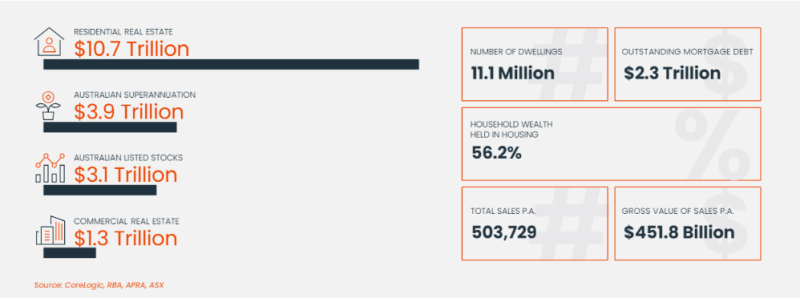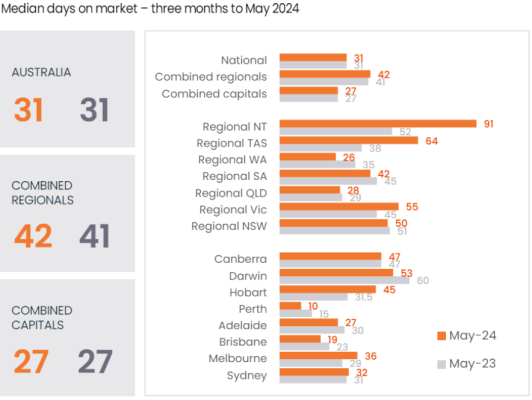Residential Real Estate underpins Australia’s Wealth.
The total value of Australian residential real estate was $10.7 trillion at the end of April 2024.

However, outstanding mortgages against all residential housing are only $2.3 trillion – a very comfortable 22% loan-to-value ratio.
56.2% of total Aussie household wealth is held in residential property—one of the many reasons the banks, the government, and the Reserve Bank of Australia (RBA) want to maintain a stable and highly regulated Real Estate Market to prevent a property crash.
The value of residential properties is increasing, driven by rising demands.
With the country’s population projected to increase by 2 million people by the end of 2030, the Labor government has announced its aim to build 1.2 million new homes by 2029. However, experts believe it will likely still fall short of Australia’s housing needs.
The national quarterly house price has now increased over 15 of the past 16 months and has risen by 9.8% over the year ending May 2024.
According to the National Housing Finance and Investment Corporation, following the market downturn in 2021-2022 due to COVID-19, the demand for residential properties is expected to exceed new supply by approximately 50,000 homes in 2024.
The national median days for residential properties is approximately 30-45 days on average.
High demand for housing has resulted in the median days on the market for residential properties remaining relatively low from 2023 to 2024, holding at 30–45 days on average.

The median days on the market for Australian residential properties have remained relatively stable from 2023 to 2024, holding at approximately 30 days.
Properties in capital cities continue to sell the fastest, with the average time on the market remaining steady at 27 days from 2023 to 2024.
The opportunity and outlook for Australian private debt.
Private lending generally involves raising capital from high-net-worth individuals, family offices or even businesses that utilize cash reserves to lend out to borrowers.
Strict capital requirements for the banks in Australia led to a narrowing of their lending parameters and a reduction in risk appetite. Also, it takes mainstream banks a significantly longer time to disburse loans due to long processes. Given the rapidly changing market and escalating house prices, securing quick and hassle-free loans can be the difference between success and failure for many borrowers.
Therefore, there are huge demands in lending business market for residential real estate where it is difficult for the banks to participate. This is where private lenders step in to fill the void. The market size for private lending for Commercial Real Estate market is growing rapidly and accounts for approximately AUD 100bn in 2024.
Bright Capital has established a partnership with Residential Credit Income Funds in Australia. If you are interested in exploring investment opportunities in Australia, please don’t hesitate to contact us for more information.

NEWSLETTER REGISTER